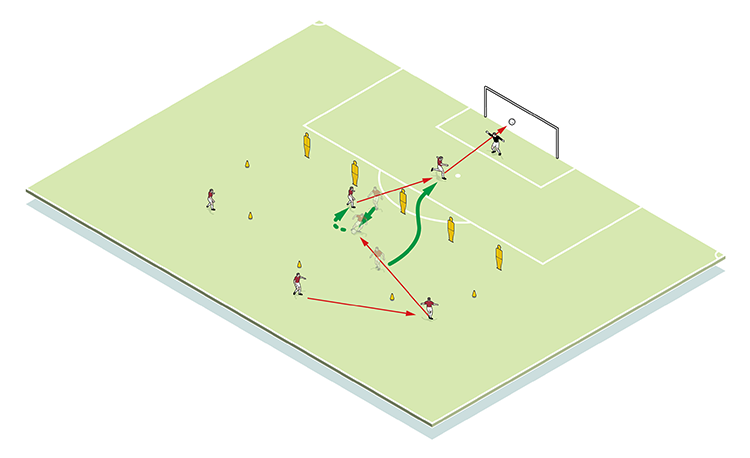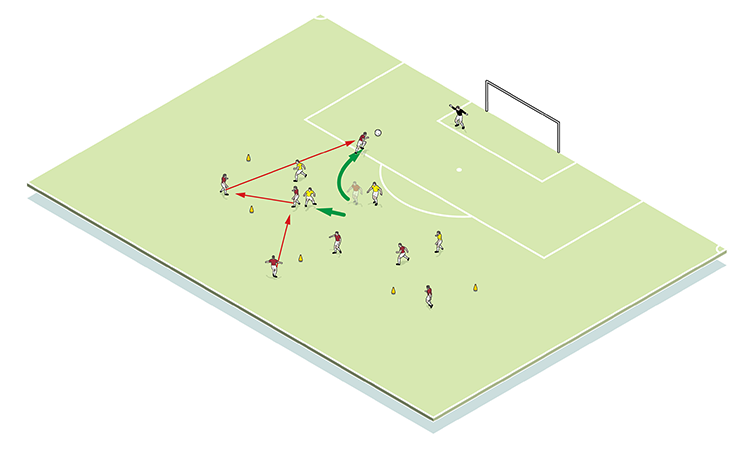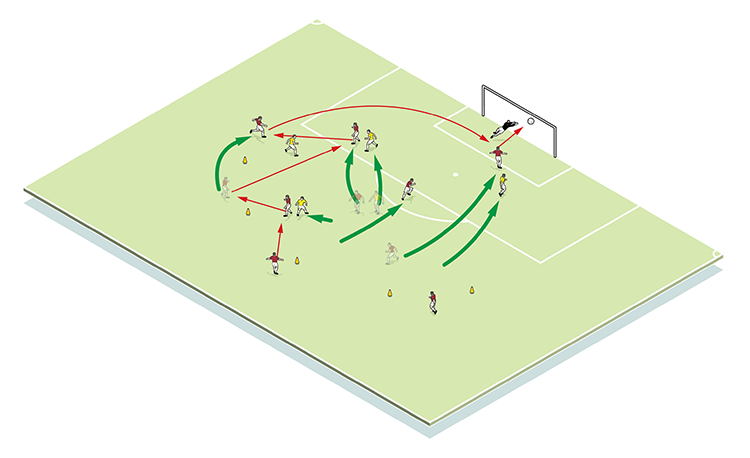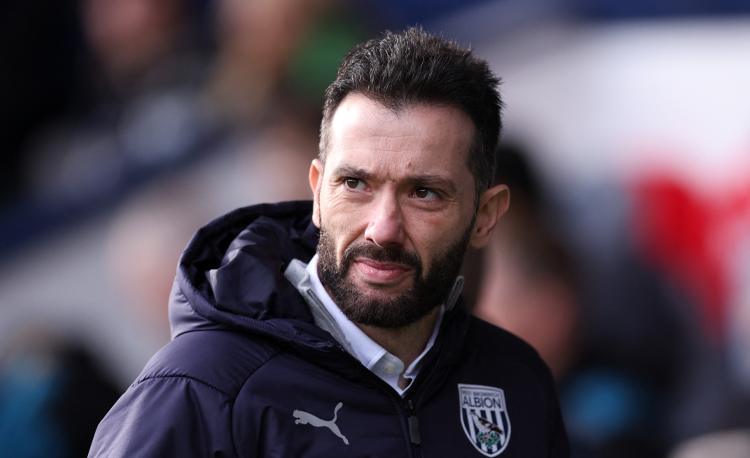You are viewing 1 of your 1 free articles
Quick combination play around the box
This session is about attacking players improving their decision-making and movement, and helps them build advanced understanding of how to create goalscoring opportunities around the box.
| Area | Half a pitch |
| Equipment | Balls, cones, goals, mannequins |
| No. of Players | Up to 12 |
| Session Time | Session 15mins, Development 20mins, Game situation 20mins |
This session is about attacking players improving their decision-making and movement, and helps them build advanced understanding of how to create goalscoring opportunities around the box.
The modern game sees more and more attacking play through central areas of the pitch, so it only seems right to construct a practice that helps improve players’ potential to exploit these areas around the box.
At first the set-up is unopposed, but we go on to introduce defenders so as to create what is essentially a match situation.
What do I get the players to do?
We set up on half a pitch but will generally use just the final third. The practice benefits from the use of five mannequins or large cones.
Attacking breaks
We set up as shown with three attackers outside an arc of cones and two more in advanced attacking positions (1). Outside players are two-touch, and must pass the ball around before feeding into the forwards. When they do receive, these forwards combine quickly, and with good timing. The end result is a threaded pass in between the mannequins (defenders) so that breaking the line presents a clear chance on goal. Ensure forwards make ‘opposite runs’ – namely one comes short while the other goes long.
1

Progression
To progress the practice we replace the mannequins with four defenders, also adding in two extra attackers. Offsides apply and attackers can lay back to outer players if it benefits the idea of having a direct and dynamic final pass that the attacker can run on to (2).
2

Again, forwards must look to play between defenders as well as ensuring they are not easily marked. Timing and direction of runs is critical – after all, the run dictates the pass.
To progress further, we can allow players behind the cones to have more of an active part in attacks. For instance, if one of these players is responsible for a final pass into the danger area, it enables attackers to time their runs onto a ball from deep, as well as offering variety in terms of how many attackers are going forward against four defenders (3).
3

How do I put this into a game situation?
Placing a goal at each end of half a pitch can produce, in effect, two halves of attack versus defence. Because there is little space to build up, what’s created is a quick set-up that transitions quickly from one team’s attack to the other’s.
Related Files
Editor's Picks
Using the goalkeeper in build-up play
Pressing principles
Intensive boxes drill with goals
Penetrating the final third
Creating and finishing
My philosophy
Pressing initiation
Compact team movement
Defensive organisation
Coaches' Testimonials

Alan Pardew

Arsène Wenger

Brendan Rodgers

Carlos Carvalhal

José Mourinho

Jürgen Klopp

Pep Guardiola

Roy Hodgson

Sir Alex Ferguson

Steven Gerrard
Related
Coaches' Testimonials

Gerald Kearney, Downtown Las Vegas Soccer Club

Paul Butler, Florida, USA

Rick Shields, Springboro, USA

Tony Green, Pierrefonds Titans, Quebec, Canada
Join the world's leading coaches and managers and discover for yourself one of the best kept secrets in coaching. No other training tool on the planet is written or read by the calibre of names you’ll find in Elite Soccer.
In a recent survey 92% of subscribers said Elite Soccer makes them more confident, 89% said it makes them a more effective coach and 91% said it makes them more inspired.
Get Monthly Inspiration
All the latest techniques and approaches
Since 2010 Elite Soccer has given subscribers exclusive insight into the training ground practices of the world’s best coaches. Published in partnership with the League Managers Association we have unparalleled access to the leading lights in the English leagues, as well as a host of international managers.
Elite Soccer exclusively features sessions written by the coaches themselves. There are no observed sessions and no sessions “in the style of”, just first-hand advice delivered direct to you from the coach.









